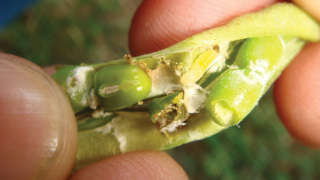
Guru GyaanAgroStar Agronomy Centre of Excellence
Management of spotted pod borer in cowpea, green gram and black gram
There may be a reproductive stage (flowering stage or pod setting stage) in the fields of cowpea, green gram moth bean or black gram. Generally, an infestation of spotted pod borer is observed at this stage in these crops. Larva enters into the pod by making a hole in the pod. None of the seeds eaten up by the larva is seen in the pods. In the absence of control measures, these larvae are capable of causing economic loss.
The larva is greenish in colour and has shorts black hairs on the body. The fully grown caterpillar is translucent and shiny with 6 rows of black spots on the body and hence is known as “Spotted pod borer”. Larva gets into the flowers, buds and pods and feeds the seeds from inside. The entry hole is plugged with excreta by the larva. Severe damage is observed under high humid weather condition.
Integrated Management:
It has been observed that two parasites from the Braconid family parasitizing on the spotted pod borer minimize the population of this pest, naturally.
· On initiation, spray neem seed kernel powder 500 g (5%) or neem oil @ 50 ml or neem-based formulations 10 ml (1% EC) to 40 ml (0.15% EC) or Bouveria bassiana, a fungus base powder @ 40 g per 10 lit of water.
· On higher infestation, spray quinalphos 25 EC @ 20 ml or triazophos 40% + cypermethrin 4% (44%) EC @ 10 ml or lufenuron 5 EC @ 10 ml or monocrotophos 36 SL @ 10 ml or thiodicarb 75 WP @ 10 g chlorantraniliprole 18.5 SC @ 3 ml per 10 lit of water.
· Spray emamactin benzoate 5 WG @ 5 g or flubendiamide 480 SC @ 2 ml or chlorantraniliprole 18.5 SC @ 3 ml per 10 lit of water especially in black gram and cowpea for the control of spotted pod borer.
· If spotted pod borer is observed in cowpea, spray indoxacarb 14.5 SC @ 3.5 ml or spinosad 45 SC @ 1.6 ml or emamactin benzoate 5 SG @ 3 g per 10 lit of water during flowering on 50% of the plants and second spray after 7 days of the first spray.
When this pest is observed in green gram, spray chlorantraniliprole 18.5 SC @ 3 ml or flubendiamide 480 SC @ 2 ml per 10 lit of water at the time of flowering on 50% of the plants.
Dr. T. M. Bharpoda,
Ex. Professor of Entomology,
B. A. College of Agriculture, Anand Agricultural University, Anand- 388 110 (Gujarat India)
If you find this information useful, click on the yellow thumbs up sign under the photo and also share this with your farmer friends using the options given below.
196
0

